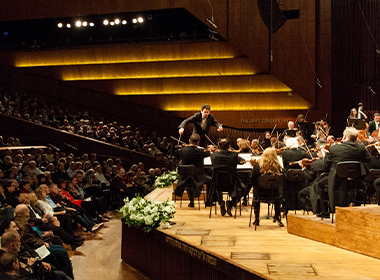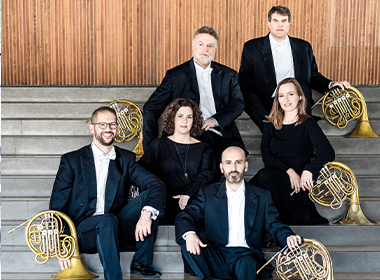The orchestra is excited to host conductor Yoel Levi again and trombonist Christian Lindberg.
Bach‘s Brandenburg Concertos were discovered by chance in the library of the nobleman Brandenburg, who commissioned the works but did not even bother to carry them out. The loss, it must be said, is his. In each of the six concertos, Bach reveals new qualities as a highly capable orchestrator. All six are masterpieces. The third Brandenburg concerto gives up a single solo instrument in favor of 3 violins, 3 violas, 3 cellos, bass and harpsichord. Bach remains faithful to the Concerto Grosso tradition, writing for a group of solo instruments with orchestral accompaniment. The big surprise is the second movement, which includes only two chords. Is it based on the ability of the harpsichord player to improvise? Each performance brings a unique solution.
In his work ”Solo” for trombone and orchestra, composer Luciano Berio offers a new approach to the concerto. It seemingly eliminates the interdependence between soloist and orchestra, which are now independent entities. Therefore, the music of these two components of the work exists simultaneously, but without regard for one another. Sometimes they share a pitch of sound, for example, or a single element, but it is not a dialogue in the tradition of Western music. He composed the piece in Rio for trombonist Christian Lindberg, after they met when Lindberg was performing as a soloist in the opera A Place, A History, and Berio was composing in Rio during this time, at the end of the last century.
What a treat to hear the piece by the soloist for whom it was written!
”If one wishes to envision the essence of Bruckner‘s artistry and life, one should listen to his Romantic Symphony. Village and school, forest and church – all are in this work, sounding and living before our eyes. Bruckner is revealed to us great and hearty”. (From an article in Fremden Blatt, Vienna, 1896).
Bruckner himself entitled this symphony ”Romantic” and this is his only symphony that has a title. However, Symphony No. 4 should not be attributed to the Romantic stream of the period in which it was composed. On the whole, Bruckner‘s music is not a continuation of the music of the major Romantic composers of the first half of the 19th century. Until his late thirties Bruckner was not acquainted with the works of Mendelssohn, Schumann or Wagner, since he lived in relative seclusion in small towns near Linz in upper Austria. The roots of Bruckner‘s music can be found mainly in Classical, Baroque and Renaissance church music.
The Fourth Symphony is the first of four symphonies (nos. 4-7) written in a major key, following Bruckner‘s previous symphonies and masses which were all in minor keys. The reason for this surprising fact may be Bruckner‘s improved financial situation and growing self-confidence as a composer. The major-key tonality that appears for the first time at the beginning of the Romantic Symphony gives a feeling of optimism, openness and freedom of all the tension that characterised Bruckner‘s earlier symphonies.
The orchestra is excited to host conductor Yoel Levi again and Mezzo-Soprano Tea Demurishvili.
When the genre of bel canto operas was extinct and Wagner‘s modern operas began to rock the musical world, Verdi wrote the opera La Forza del Destino, which he considered as the ”first of his modern operas”.
The first performances in St. Petersburg in November 1862, as well as the first ones in Italy, were not very successful, mainly due to the opera‘s unusual length, as well as its bloody ending. In order to make it more popular, Verdi revised the opera in 1868-9. In the second version some of the scenes were rearranged. In addition, the long famous overture, played tonight, was written. In the period between the two versions of La Forza Verdi wrote the opera Don Carlo. The development of Verdi‘s style during that time is noticeable in this impressive piece, Verdi‘s best known overture.
Carmen, Bizet‘s last work, caused a major furor following its premiere at the Opéra Comique. The critics and the audience were appalled by Bizet‘s ”daring”, which was reflected, according to them, in his audacity to present on stage such immodest and immoral behavior as a heroine who declares openly that ”none of her love affairs lasts more that six months”. Although the music sounds Spanish, it is Bizet‘s original creation. He evokes the typical local spirit with very little use of authentic Spanish melodies. The story takes place in and near Seville, in the south of Spain.
Near the cigarette factor soldiers, workers, citizens and childreny stroll about. Carmen, a beautiful, hot-blooded gipsy, works in the cigarette factory. She and her co-workers are like a lodestone for the men of the local cavalry regiment. Carmen shamelessly flirts with Don José, and sings (after a melody by the Spanish composer Sebastian Iradier) the lilting Habanera (an ancient Spanish-Cuban dance rhythm) about the frivolity of love (”Love is a rebellious bird”).
Composed in 1867 after Schiller‘s drama, and revised in 1884, Don Carlo is a transitional work between the ”melodious” and ”dramatic” Verdi. The plot depicts the tragic love of Don Carlo, heir to the Spanish throne, and the daughter of the King of France, Elisabeth de Valois, who is married to Don Carlo‘s father, King Philip, against her will. Princess Eboli is also in love with Carlo, but when he rejects her advances, Eboli realizes where the prince’s true feelings lie and swears to expose him. She betrays her Queen and friend, informing King Philip of the love between his wife and his son. The King imprisons his son, much to the sorrow of Eboli. In retaliation, Elizabeth gives Princess Eboli the choice of being exiled or becoming a nun. In her aria, O don fatale (O terrible gift, o cruel gift), Eboli curses the gift of beauty that she has been given, saying that it has been the cause of all her problems. She swears to save Carlo from the imprisonment that has resulted from her betrayal.
Il Trovatore is the second of three operas written by Verdi at the beginning of the 1850‘s, works that ultimately turned him into the greatest Italian opera composer of his time (the other two are Rigoletto and La Traviata).
The protagonists of Il Trovatore are driven by one passion from the beginning of the opera to its end: Count di Luna is madly in love with Leonora and is ready to abandon his men for her, when he comes to kidnap her from the monastery and confronts Manrico‘s men. Leonora is totally given to Manrico and sacrifices first her position and comfortable life in court, and eventually her own life for him. Manrico is torn between his love for Leonora and his love, of erotic nature, for the woman he believes to be his mother, Azucena. The latter, Verdi‘s most unique contribution to the repertoire of operatic characters, is, in turn, torn between the wish to avenge her mother‘s death and her love for her adopted son, Manrico.
Beethoven was a great Nature lover and preferred solitude in the countryside to the company of people. One of his English friends wrote: ”…Never have I met another person whom flowers or clouds make so happy!”
Composing did not come easily to Beethoven. While walking in fields and woods, he would carry a small notebook and a pencil in his pocket, and each time a musical idea occurred to him, he would write it down. Later, at home, he would copy it onto a music sheet, but until this or that idea reached its final stage, it underwent numerous metamorphoses.
The sixth symphony, ”Pastoral”, indeed was inspired by Nature, which he loved so much, and written while Beethoven was spending the summers of 1807 and 1808 in the town of Heiligenstadt. The symphony deals with simple rural joys and with Nature‘s beauty, as well as with its wild and stormy side. Yet, it is not a programmatic work with exact descriptions of Nature such as The Four Seasons by Vivaldi. It is more the composer‘s musical impression of Nature and the landscape. On the first page of the programme booklet for the premiere on 22 December 1808 in Vienna, Beethoven wrote: ”Pastoral Symphony, or Recollection of Life in the Countryside (more an expression of feelings than painting)”. As he himself said: ”Painting carried too far in instrumental music loses its effect”. Nevertheless, to each of its five movements he appended a descriptive subtitle, suggesting its content.
Beethoven, the greatest innovator of symphonic structure at the beginning of the nineteenth century, influenced all the composers who followed him. One of his innumerable innovations is seen in this enchanting symphony: it is the only one in which he deviated from the traditional formula of the four-movement symphony, adding a fifth one.
program no. 1
Yoel Levi, conductor
Christian Lindberg, trombonist
Bach: Brandenburg Concerto no. 3
Berio: SOLO for Trombone and Orchestra
Bruckner: Symphony no. 4
program no. 2
Yoel Levi, conductor
Tea Demurishvili, mezzo-soprano
Verdi: Overture to La forza del destino
Verdi: Azucena’s arias from Il trovatore
Bizet: Habanera from Carmen
Bizet: Excerpts from Carmen Suites No. 1 and 2
Verdi: Eboli’s aria from Don Carlos
Beethoven: Symphony no. 6 ("Pastoral")








 Back to top
Back to top





